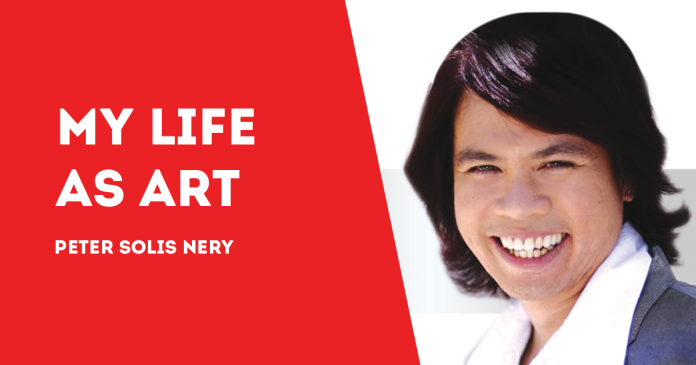
“HEART of My Youth” by Peter Solis Nery compiles three of his early memoirs written in the late 1990s. Published in the US this August 2020, the book contains “The Essential Thoughts of a Purple Cat” (1996), “Moon River, Butterflies, and Me” (1997), and “My Life as a Hermit” (1998).
Previously in this column, Manuel Radislao (of La Consolacion College in Bacolod City) wrote about the roles of Moon River, Satoshi, Gio, and Leo in the life of the young Peter Solis Nery, the author-self in “Moon River, Butterflies, and Me”.
Here’s the concluding part of Radislao’s new introduction to an “old” book.
*
GIFT OF WINGS: A FLIGHT INTO THE HEART, Part2
by Manuel J. Radislao
*
The second theme that runs through the essays is the realm of the imagination. Peter is hurled into the imaginative world of language, art, and performance ritual. It is in the light of this theme that the author-self confesses his first love. Mary Rose, a college friend, soaked him into French culture — language, literature, and film. The author-self also declares that it was Mary Rose’s retelling, in French and English, of Antoine de Saint-Exupéry’sThe Little Prince that made her unforgettable. The author has become Mary Rose’s object of love, who (like the Little Prince’s fox) had to be tamed and controlled. The author-self says, “she initiated me to the great mysteries and minor ecstasies of Life.” But like any tragic love stories, Mary Rose died early of a liver disease. Like the many butterflies that came into his life, Mary Rose was also fleeting.
*
After college, the author tried his hand at many social advocacies, and even did some odd jobs like editing papers while pursuing some worthy causes. In this phase of Peter’s life, he met Jolly, Smiley, and Gaye — three “witches” he had taken in as roommates to share his monthly house rental. The girls’ nightly rituals and ancient esoteric celebrations of the feminine attracted Peter, which he claimed, taught him lessons on self-appreciation, and creation-centered spirituality. At this time, Peter became immersed in the New Age movement of self-care and self-mastery.
*
The third part of the book explores the theme of flight — a letting go of things and events that could not be kept to oneself. This form of liberation and freedom dominates the narratives of the author-self with three significant persons: Padre Miguel, a Cantonese priest who taught him about death and dying; Ze, a young Portuguese friend whom the author-self met while teaching in Macau; and Takashi, the son of his foster parents during his brief sojourn in Japan.
*
But what makes Peter’s book memorable is not only the lyrical use of language, or the pathos and tragedies of friendships and losses, but also the intrusion of beautiful literary creations that inspired those experiences. One of the literary delights in this book is Peter’s confessional letters — 13 missives were written for one person alone. Those letters best capture the inchoate expressions of the heart — the pain of unrequited love, and the unspeakable pain of separation. Another feast for the imaginative eye is Peter’s Japanese-inspired haiku. Take this poignant three-liner on the pain of remembrance:
*
firefly light
makes good lantern
for reading your letters
*
The master storyteller and essayist gives more to the delight of the reader. Some of the profound lessons on love and friendship can be found in the missives to Ze, one of which was dated April 19. It dramatizes for the reader this beautiful friendship that has become a treasure to keep. In the letter, one feels the pain of this friendship coming to an end as the author writes: After all, we met for a flicker of an instant. We understood beauty, and we drifted just like that. Butterflies are not forever, but their beauty and passion for what is beautiful far surpasses diamonds.
*
Books such as this could not literally be put down. Readers go back to those memorable lines that struck a chord with them. As this reader ruminates on those meaningful passages written by the author, one could simply give a nod of approval that any good work of literature does not only delight, but also instructs.
*
The book concludes with the author’s postscript, an invitation for his readers to embrace change, a challenge to become like a butterfly — which dares to extricate itself from the darkness of the cocoon to take flight, and to bring loveliness and beauty to God’s creation. In the words of Peter Solis Nery: Butterflies spread the beautiful hues of the rainbow upon their delicate wings. They brighten the air with their healing colors as they flutter, and bring joy and beauty wherever they go. Butterflies may as well be our redemption from this world too ugly and too violent. Because in their tenderness, fragility, and delicate beauty, mercy, compassion, and understanding are aroused in us.
*
Now, who says autobiographical writing is boring?/PN

